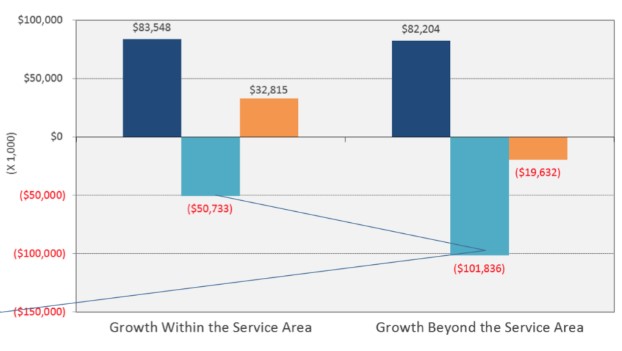When the first draft of the Suffolk 2045 Comprehensive Plan was published about a year ago, Care4Suffolk raised the flag about the missing Fiscal Impact Analysis (FIA). Our concerns were brushed off and we were told it wasn’t necessary. City Council went on to adopt the comp plan in December of 2024 with big changes and without a public hearing or public notice.
This is all old news, so why do we bring it up? The answer is because the City’s lack of concern about the fiscal analysis is very relevant right now.
Just last week, City Council approved the annual Capital Improvements Program (CIP) and this week our real estate assessments will be mailed out. How much the City receives in revenue, and what it pays in services and capital improvements, is at the very heart of an FIA.
(For context, land valuations for Suffolk residential properties are up over 6% this year and the ten year outlook for capital improvement costs has reached $2 billion–an increase of $1billion from a few years ago).
Back on May 1, 2024, City Council and Planning Commission held a joint meeting about the draft of the 2045 Comp Plan where they heard a presentation by city staff. (You can read more about it here.) It was at that meeting that Comprehensive Planning Manager Keith Cannady assured council members and commissioners that the City didn’t need to do a FIA for the comp plan because they are done at the “site level” for individual developments during rezoning requests. He also said that the City’s current fiscal analysis tool needs work, so it isn’t a useful tool at the moment. Additionally, he stated that since the City wasn’t considering changing its growth strategy, a FIA for the comp plan wasn’t necessary.
As a counterpoint to Mr. Cannady’s argument that FIAs are conducted at the site level, we did a FOIA request and received a copy of the FIA that was done for the Port 460 Project. A fiscal impact analysis is supposed to show the revenue that a development will generate and the costs of services that the development will require. However, this site-level FIA was done by the developer and did not contain the required costs of services portion. The City can not accurately understand if a development will be fiscally net negative or positive in the long-run without the essential costs of services component.
Port 460 was arguably the largest rezoning request in Suffolk in years, yet staff recommended approval and City Council voted to approve it without an accurate idea of what the costs of the project would be for the City in the long-term.
We do know that there was also no FIA done for the 2035 Comprehensive Plan (adopted in 2015). We know, via another FOIA request, that the original Request for Proposal (RFP) and the contract for the 2045 Comp Plan (signed in early 2021), included the task of updating the fiscal impact tool and a Fiscal Impact Analysis, considering multiple growth models, to be completed during the plan’s development. City staff at that point (late 2020) clearly knew that the fiscal impact tool needed to be updated and understood that it is typically used as part of a comprehensive plan process.
In May of 2022, a group of city staff and comp plan consultants held a Land Use Workshop, one of the three main purposes of which was to “determine fiscal model objectives and data needs.”
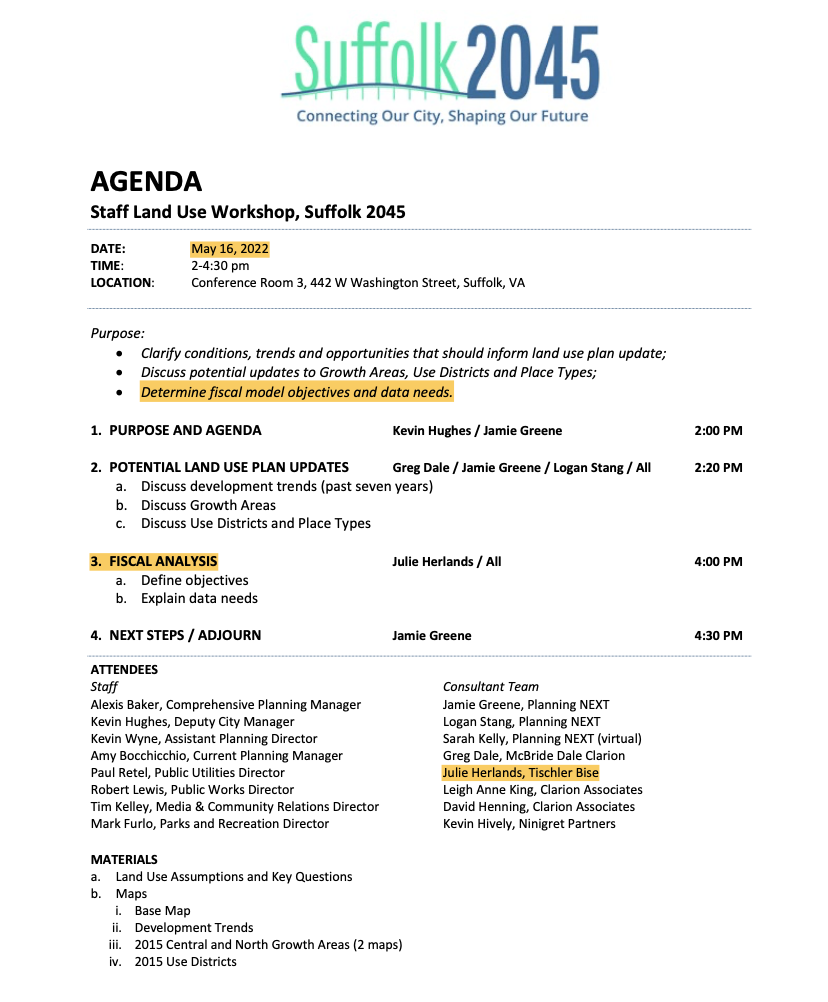
In September 2022 the comp plan steering committee meeting apparently included quite a lengthy presentation about the role of a Fiscal Impact Analysis in the comprehensive plan. We obtained, via FOIA, the attendance list for this and other steering committee meetings:
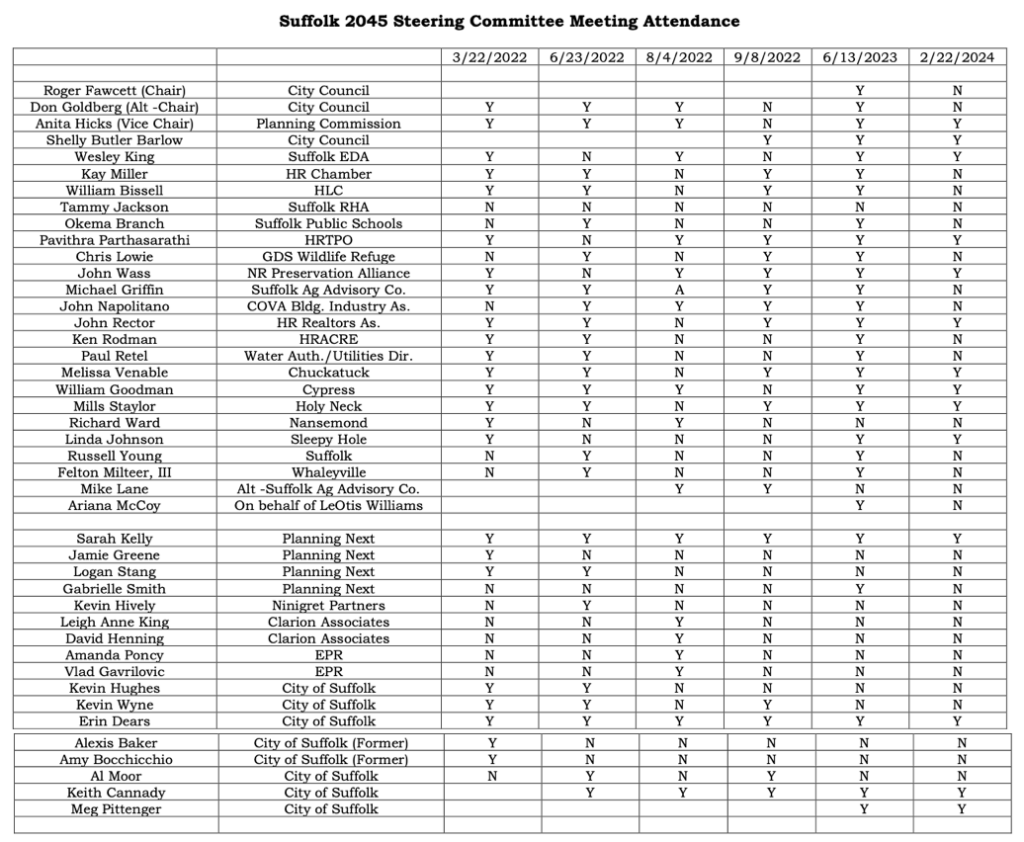
The slide presentation from this meeting was available on the 2045 Comp Plan website and most of it is about the FIA and its importance in both the comprehensive plan process and in aiding city staff with evaluating development.
Below are some slides from that presentation:
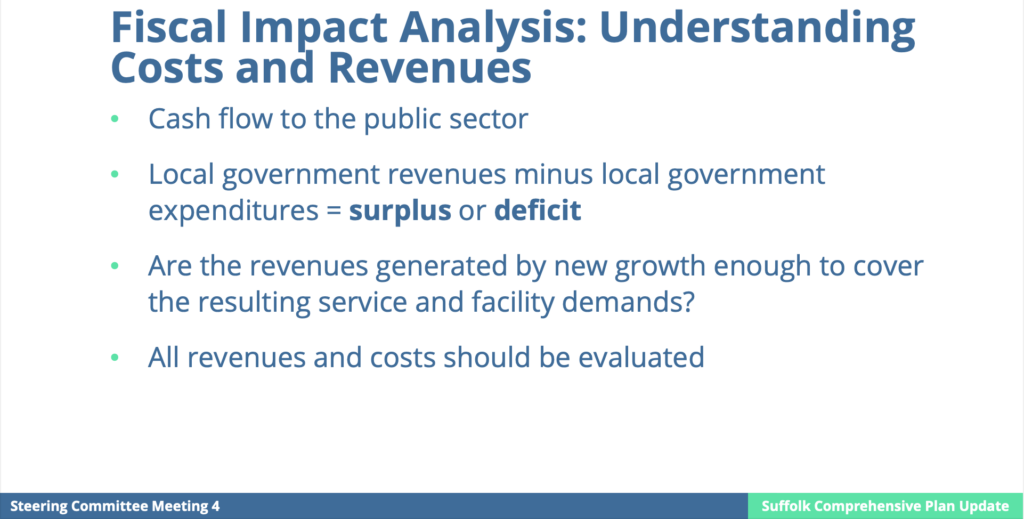
This slide, Fiscal Impact Analysis: Understanding Costs and Revenues, covers what a FIA is and why it is important – will the revenue generated by new growth be enough to cover the resulting services and facility demands? This is a very important question that city staff and City Council should be asking, not just during the comp plan process, but also during each rezoning request. If development requires more services or capital improvements than the development will raise in revenue, the shortfall has to be covered by the city – paid for by taxpayers.
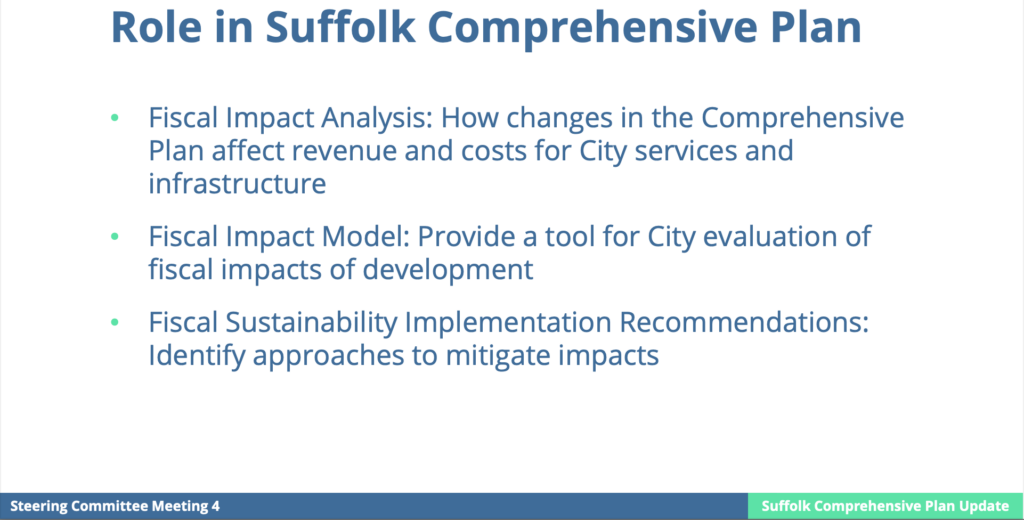
In this next slide, Role in Suffolk Comprehensive Plan, a key talking point was how a FIA can be used in the comp plan process to see how changes will affect revenues and costs for city services and infrastructure. We know that the contract included comparing three development models for the comp plan, so that the City could compare different models on a fiscal level. By the time of the draft release, the staff had decided not to consider any other growth models than what it’s currently using.
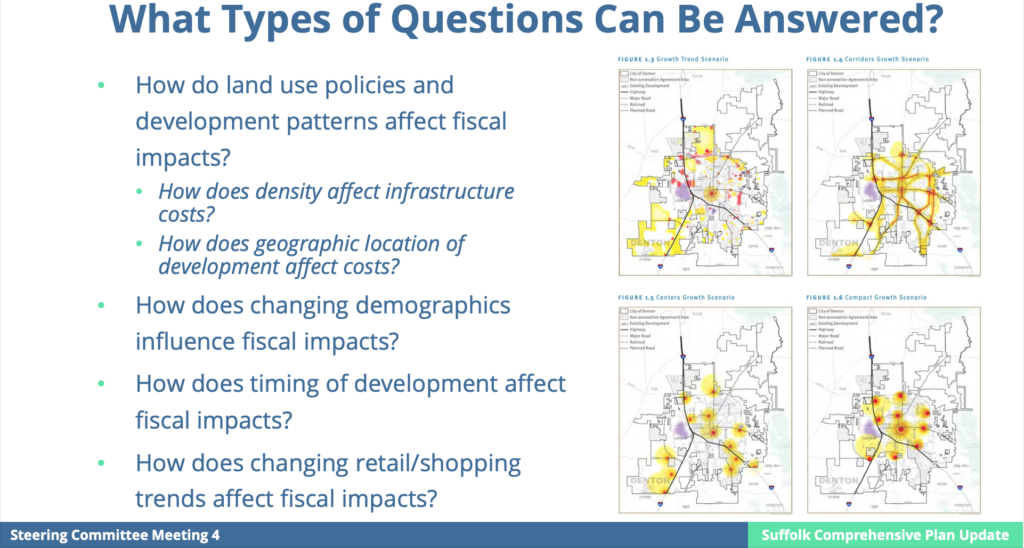
In this slide, What Types of Questions Can Be Answered?, we can see how land use policies and development patterns affect fiscal impacts. It is clear that staff was presented with the idea that different types of growth models have different fiscal impacts.
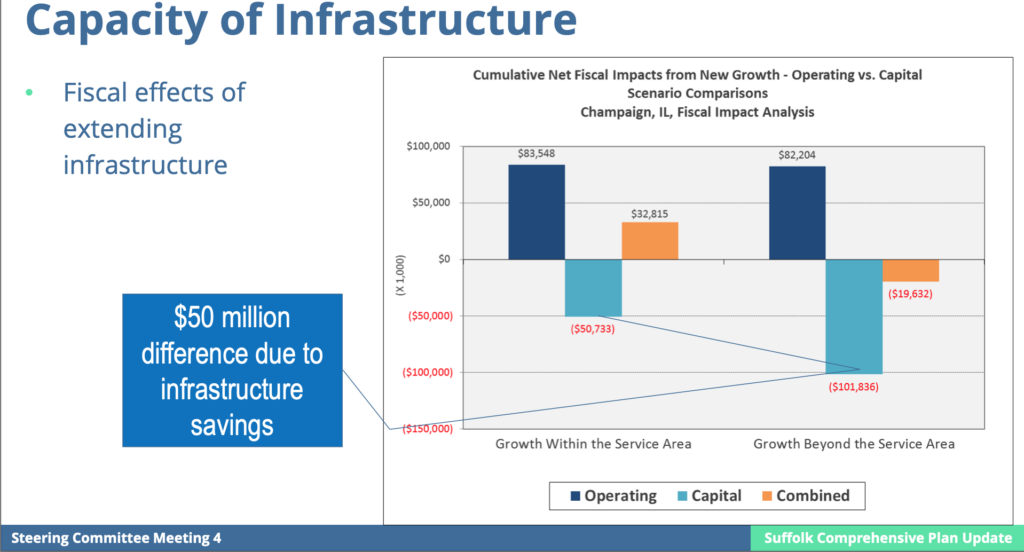
This slide, Capacity of Infrastructure, contains a real life example from Champaign, IL and the two model types it was comparing. Champaign was comparing “Growth Within the Service Area” and “Growth Beyond the Service Area” and the fiscal impact analysis showed that “Growth Beyond the Service Area” created a $50 million difference in additional capital infrastructure costs. It costs more money to extend into areas that lack infrastructure, like roads, water, sewers, storm water drainage, etc. versus building within areas that already contain many of these services. Suffolk’s “managed growth approach” for decades has been to extend growth areas into predominantly agricultural areas, which tend to lack the essential infrastructure needed for large residential neighborhoods and non-residential uses. This method of growth can be more expensive than growing within existing infrastructure, yet the City chose not to consider other growth options.
Fast forward to that May 2024 joint meeting, and Council Members Johnson and Butler Barlow, along with Commissioner Baur, all asked the city planner questions about the FIA. They wanted to understand why it wasn’t done.
Mr. Cannady’s response is below:
“The original RFP, and this was November of 2020, actually recommended that the city evaluate the different growth strategies that could come out of this process, for their fiscal impacts. In other words, if we picked something very different from the growth management approach that we’re following, it would be good to evaluate that new alternative for its fiscal impact. As this plan developed, we realized we were gonna stick with our basic growth management approach, so it didn’t really make sense to evaluate something that we weren’t going to seriously consider.”
– Mr. Keith Cannady, Joint Session of the Suffolk City Council and Suffolk Planning Commission, May 1, 2024
According to Mr. Cannady, the FIA is only necessary if the city wants to change its growth strategy. However, the current approach was never fiscally evaluated in 2015 when the 2035 Comp Plan was adopted, so we don’t know if the strategy that’s been used for at least a decade is even fiscally sound.
The comprehensive plan is the single most important piece of policy for the City. It is a 20-year, long-range plan that guides all future development in Suffolk and city staff chose to be willfully ignorant to the fiscal impacts of this growth strategy AND refused to consider any other models for comparison.
Later he adds:
“I think what we wanted to make sure is that you all understood what we recommended several months ago, and have been recommending actually for quite a while, the way to go forward with the fiscal impact analysis. I think there was some concern that, ah, we took out a step that we should have taken. Ah, that we um should have had this analysis done because it was in the RFP. Ah, and I don’t believe that’s the case. I believe we made a good recommendation based on the ah plan that was developing, um, and the strategies and priorities that we needed to set going forward. I think it would have been, frankly, a waste of our time and our money to evaluate options that were essentially all the same.”
– Mr. Keith Cannady, Joint Session of the Suffolk City Council and Suffolk Planning Commission, May 1, 2024
In the video above, we here Mr. Cannady talk about recommendations. This was not a recommendation as Mr. Cannady characterizes it. City staff that made the unilateral decision. When Care4Suffolk spoke with most of the City Council members and Planning Commissioners, not a single one said to us that they were aware of the removal of the FIA from the comp plan process, despite several of these individuals being on the comp plan steering committee. It was also surprising because the Planning Commission, according to Virginia state law, was the body responsible for leading the comp plan process.
Instead of listening to the expert advice that was already budgeted for and following the contract to analyze three different growth methods for their fiscal benefits and burdens, City staff decided to simply continue its current “strategy”– a strategy that is known to potentially increase costs. These are the kind of decisions that can cause budget shortfalls down the road, requiring taxes to be increased. Knowing this, staff still felt that the fiscal impact analysis would be, as Mr. Cannady said, “…frankly, a waste of our time and our money”.
The City staff, at some point during this process, decided that we, the taxpayers, don’t need or want choices for future growth in our city. There was a plan developing and those ‘strategies’ and ‘priorities’, that Mr. Cannady alluded to, made looking at alternatives unnecessary, possibly even inconvenient.
Maybe we can garner some insight from Mr. Cannady’s explanation below:
“I think one of the things that we were concerned about, um and I think the city is concerned about too, is um when it comes to those larger employment center types of uses, we realized that we just didn’t have room within the current growth area boundary to be a part of that growth opportunity that this region has. And so when we put some options out that we thought would allow us to do that. And that one, [Rt] 460, was one of those corridors. I don’t disagree with you that’s a significant change in land use and expansion of the growth area, but we felt like to take advantage of um that opportunity that the city has um providing an area that’s in a good location, you can effectively, cost effectively extend utilities to it and capture some of those economic development opportunities, was something we all needed to think about, recognizing that there are some trade offs there.”
– Mr. Keith Cannady, Joint Session of the Suffolk City Council and Suffolk Planning Commission, May 1, 2024
There’s that word: “Regional.” We keep hearing this over and over again. There are regional interests pushing to build here and to do that, the City of Suffolk has to expand its growth areas and drastically change land use. Mr. Cannady actually is in agreement that these changes are significant, which is in direct contradiction to his previous statement early in the meeting that we didn’t need to do the FIA because we weren’t really changing anything.
Let’s recap: Suffolk has had a growth strategy to expand its growth areas into agricultural areas. The City’s fiscal analysis tool has not been fixed in many years, so fiscal impacts of all development over this time period were not adequately evaluated. Staff had the opportunity to look at the costs of this growth, as well as compare it to some alternative growth methods, but decided it wasn’t ‘worth the time or money’. Staff stated the reason the growth areas need to be drastically expanded is for ‘economic development opportunities’.
How can staff, with a straight face, seriously say that it is NOT in the best interest of the City to analyze cost benefits and burdens, but then use the excuse that this is being done for economic development? That is essentially saying that we don’t need data about the money, but we are doing this for more money.
Decisions about taxpayer money should ALWAYS be based on data.
There is no data to support that the enormous growth laid out in the 2045 Comp Plan will be a net positive fiscal opportunity for Suffolk. This could just as easily be a boondoggle that burdens us with infrastructure costs for decades (like the latest $2 billion ten-year CIP!) Mr. Cannady doesn’t know, we don’t know, and no one knows, because staff chose NOT to do the fiscal analysis.
The City staff, who work on behalf of the citizens of Suffolk, didn’t want to look at what this development model will cost Suffolk residents, nor consider any alternatives that might be better for the taxpayers.
A large portion of the citizenry is not happy with the current development model the City is using. During the comp plan public engagement sessions, the majority of citizens specifically asked to slow development down, so infrastructure can catch up. But instead, growth will be accelerated with the 2045 Comp Plan. We are paying more in taxes, but our quality of life has deteriorated. Traffic is worse, more roads need repairs and improvements, storm water is a recurring issue, our waterways are ‘impaired’, and many of our schools remain over-crowded. As evidence of citizen frustration, last November, the council member in charge of the comp plan was voted out of office and the mayor barely made it back into office, receiving only one-third of the vote and winning by only about 100 votes.
Maybe the reason why our costs are going up and our quality of life is going down is because this growth model isn’t working. Maybe all the development that the City has been approving for a decade or more is costing more money than it’s generating in revenue. Maybe the FIA would have shown this. If the FIA showed a negative fiscal impact, that would have been very inconvenient for those that want to implement these Regional goals (read more about regional goals here and here.)
Let us be clear: – it isn’t that the City can’t know what all this development will cost taxpayers, it’s that the City chose to NOT know.
City leadership needs to acknowledge that they have been making huge land use changes without complete fiscal data. Those who are responsible for these poor decisions need to go. Suffolk can NOT continue to force the taxpayers to foot the bill for bad development decisions.
